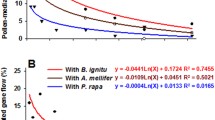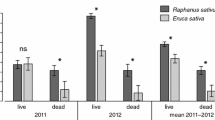Abstract
With the widespread distribution of transgenic cotton plants, concerns over their potential effects on beneficial insects and other non-target pests have been raised. In the present study, the field and laboratory effects of Cry1Ac/CpTI transgenic cotton pollen on the pollinating beetle Haptoncus luteolus were investigated. Abundance of adult beetles was studied in cotton plots at two sites in Wuhan in 2009, and the average number of adults per flower was recorded. Life-history parameters including developmental duration, hatch rate, pupation rate, emergence rate and egg number per female, as well as the survivorship curves of H. luteolus were studied in laboratory experiments. The results showed that the adult abundance in the field did not differ significantly between non-transgenic and transgenic cotton, the exposure to Cry1Ac/CpTI pollen in laboratory had no effect on the developmental time, hatching rate, pupation rates and emergence rates of H. luteolus, no significant differences were found in the mating rates and the fecundity between treatments, and the survival curves of both treatments also resulted in no significant differences. It indicated there were no significant direct adverse effects of transgenic cotton pollen on H. luteolus both in the field and in the laboratory. Our study bridged the gap of environmental risk assessment of transgenic cotton for pollinators other than pollinating bees.


Similar content being viewed by others
References
Ahmad A, Wilde GE, Whitworth RJ, Zolnerowich G (2006) Effect of corn hybrids expressing the coleopteran-specific Cry3Bb1 protein for corn rootworm control on above ground insect predators. J Econ Entomol 99:1085–1095
Álvarez-Alfageme F, Ferry N, Castañera P, Ortego F, Gatehouse AMR (2008) Prey mediated effects of Bt maize on fitness and digestive physiology of the red spider mite predator Stethorus punctillum Weise (Coleoptera: Coccinellidae). Transgenic Res 17:943–954
Álvarez-Alfageme F, Ortego F, Castañera P (2009) Bt maize fed-prey mediated effect on fitness and digestive physiology of the ground predator Poecilus cupreus L. (Coleoptera: Carabidae). J Insect Physiol 55:144–150
Bai YY, Jiang MX, Cheng JA (2005) Effects of transgenic cry1Ab rice pollen on fitness of Propylea japonica (Thunberg). J Pest Sci 78:123–128
Biesmeijer JC, Roberts SPM, Reemer M, Ohlemüller R, Edwards M, Peeters T, Schaffers AP, Potts SG, Kleukers R, Thomas CD, Settele J, Kunin WE (2006) Parallel declines in pollinators and insect-pollinated plants in Britain and the Netherlands. Science 313:351–354
Dhillon MK, Sharma HC (2009) Effects of Bacillus thuringiensis δ-endotoxins Cry1Ab and Cry1Ac on the coccinellid beetle, Cheilomenes sexmaculatus (Coleoptera, Coccinellidae) under direct and indirect exposure conditions. Biocontrol Sci Technol 19:407–420
Duan JJ, Head G, McKee MJ, Nickson TE, Martin JW, Sayegh FS (2002) Evaluation of dietary effects of transgenic corn pollen expressing Cry3Bb1 protein on a non-target ladybird beetle, Coleomegilla maculata. Entomol Exp Appl 104:271–280
Duan JJ, Marvier M, Huesing J, Dively G, Huang ZY (2008) A meta-analysis of effects of Bt crops on honey bees (Hymenoptera: Apidae). PLoS ONE: e1415. doi: 10.1371/journal.pone.0001415
Erik S (2006) Pollinator diversity declining in Europe. Science 313:286
Ferry N, Mulligan E, Stewart CN, Tabashnik B, Port G, Gatehouse AMR (2006) Prey-mediated effects of transgenic canola on a beneficial, non-target, carabid beetle. Transgenic Res 15:501–514
Ferry N, Mulligan E, Majerus M, Gatehouse A (2007) Bitrophic and tritrophic effects of Bt Cry3A transgenic potato on beneficial, non-target, beetles. Transgenic Res 16:795–812
Gao YL, Wu KM, Gould F (2009) Frequency of Bt resistance alleles in H-armigera during 2006–2008 in northern China. Environ Entomol 38:1336–1342
Guo BS, Yang JM, Xu YB (2001) Problems and research advance of the pollination insects. Southwest China J Agr Sci 14:102–108
Head G, Moar M, Eubanks M, Freeman B, Ruberson J, Hagerty A, Turnipseed S (2005) A multiyear, large-scale comparison of arthropod populations on commercially managed Bt and non-Bt cotton fields. Environ Entomol 34:1257–1266
Li W, Wu K, Chen X, Feng H, Xu G, Guo Y (2003) Effects of transgenic cottons carrying Cry1A + CpTI and Cry1Ac genes on the diversity of arthropod community in cotton fields in northern China. Chin J Agric Biotechnol 11:383–387
Liu B, Xu CR (2003) Research progress on the impacts of transgenic resistant plants on pollinating bees. Acta Ecol Sin 23:946–955
Liu W, Wan F, Guo J (2002) Structure and seasonal dynamics of arthropods in transgenic Bt cotton field. Acta Ecol Sin 22:729–735
Liu B, Xu C, Yan F, Gong R (2005) The impacts of the pollen of insect-resistant transgenic cotton on honey bees. Biodivers Conserv 14:3487–3496
Liu B, Shu C, Xue K, Zhou K, Li X, Liu D, Zheng Y, Xu C (2009) The oral toxicity of the transgenic Bt + CpTI cotton pollen to honeybees (Apis mellifera). Ecotox Environ Saf 72:1163–1169
Luo F (2004) Basic research on one kind of pollination beetle in protected field agriculture—Haptoncus luteolus: Master degree thesis. Huazhong Agricultural University, Wuhan, China
Luo F, Lei CL (2002) Haptoncus luteolus (Erichson)—one kind of pollinators with prospective future. Entomol Knowl 39:305–306
Malone LA, Pham-Delègue MH (2001) Effects of transgenic products on honey bees (Apis mellifera) and bumblebees (Bombus sp.). Apidologie 32:287–304
Malone LA, Burgess EPJ, Gatehouse HS, Voisey CR, Tregidga EL, Philip BA (2001) Effects of ingestion of a Bacillus thuringiensis toxin and a trypsin inhibitor on honey bee flight activity and longevity. Apidologie 32:57–68
Meissle M, Vojtech E, Poppy GM (2005) Effects of Bt maize-fed prey on the generalist predator Poecilus cupreus L. (Coleoptera: Carabidae). Transgenic Res 14:123–132
Moser SE, Harwood JD, Obrycki JJ (2008) Larval feeding on Bt hybrid and non-Bt corn seedlings by Harmonia axyridis (Coleoptera : Coccinellidae) and Coleomegilla maculata (Coleoptera : Coccinellidae). Environ Entomol 37:525–533
Naranjo SE (2005a) Long-term assessment of the effects of transgenic Bt cotton on the function of the natural enemy community. Environ Entomol 34:1211–1223
Naranjo SE (2005b) Long-term assessment of the effects of transgenic Bt cotton on the abundance of nontarget arthropod natural enemies. Environ Entomol 34:1193–1210
Romeis J, Meissle M, Bigler F (2006) Transgenic crops expressing Bacillus thuringiensis toxins and biological control. Nat Biotechnol 24:63–71
Romeis J, Bartsch D, Bigler F, Candolfi MP, Gielkens MMC, Hartley SE, Hellmich RL, Huesing JE, Jepson PC, Layton R, Quemada H, Raybould A, Rose RI, Schiemann J, Sears MK, Shelton AM, Sweet J, Vaituzis Z, Wolt JD (2008) Assessment of risk of insect-resistant transgenic crops to nontarget arthropods. Nat Biotechnol 26:203–208
Rose R, Dively GP, Pettis J (2007) Effects of Bt corn pollen on honey bees: emphasis on protocol development. Apidologie 38:368–377
Schmidt JEU, Braun CU, Whitehouse LP, Hilbeck A (2009) Effects of activated Bt transgene products (Cry1Ab, Cry3Bb) on immature stages of the ladybird Adalia bipunctata in laboratory ecotoxicity testing. Arch Environ Contam Toxicol 56:221–228
Sharma HC, Arora R, Pampapathy G (2007) Influence of transgenic cottons with Bacillus thuringiensis cry1Ac gene on the natural enemies of Helicoverpa armigera. Biocontrol 52:469–489
Sisterson MS, Biggs RW, Olson C, Carrière Y, Dennehy TJ, Tabshnik BE (2004) Arthropod abundance and diversity in Bt and non-Bt cotton fields. Environ Entomol 33:921–929
Steffan-Dewenter I, Potts SG, Packer L (2005) Pollinator diversity and crop pollination services are at risk. Trends Ecol Evol 20:651–652
Stokstad E (2007) Entomology: the case of the empty hives. Science 316:970–972
Tabashnik BE, Gassmann AJ, Crowder DW, Carrière Y (2008) Insect resistance to Bt crops: evidence versus theory. Nat Biotechnol 26:199–202
Torres JB, Ruberson JR (2005) Canopy- and ground-dwelling predatory arthropods in commercial Bt and non-Bt cotton fields: patterns and mechanisms. Environ Entomol 34:1242–1256
Torres JB, Ruberson JR (2006) Interactions of Bt-cotton and the omnivorous big-eyed bugGeocoris punctipes (Say), a key predator in cotton Welds. Biol Control 39:47–57
Wan FH, Liu WX, Guo JY (2002) Comparison analyses of the functional groups of natural enemy in transgenic Bt-cotton field and non-transgenic cotton fields with IPM, and chemical control. Acta Ecol Sin 22:936–942
Whitehouse MEA, Wilson LJ, Constable GA (2007) Target and non-target effects on the invertebrate community of Vip cotton, a new insecticidal transgenic. Aust J Agr Res 58:273–285
Wu KM, Guo YY (2005) The evolution of cotton pest management practices in China. Annu Rev Entomol 50:31–52
Acknowledgements
We thank Ms. Kuang Meiyun for collecting cotton pollen. This study was supported by the National Special Transgenic Project from the Chinese Ministry of Agriculture (2008ZX08011-002).
Author information
Authors and Affiliations
Corresponding author
Additional information
Communicated by M. Traugott.
Rights and permissions
About this article
Cite this article
Chen, L., Cui, J., Ma, W. et al. Pollen from Cry1Ac/CpTI-transgenic cotton does not affect the pollinating beetle Haptoncus luteolus . J Pest Sci 84, 9–14 (2011). https://doi.org/10.1007/s10340-010-0319-0
Received:
Accepted:
Published:
Issue Date:
DOI: https://doi.org/10.1007/s10340-010-0319-0




